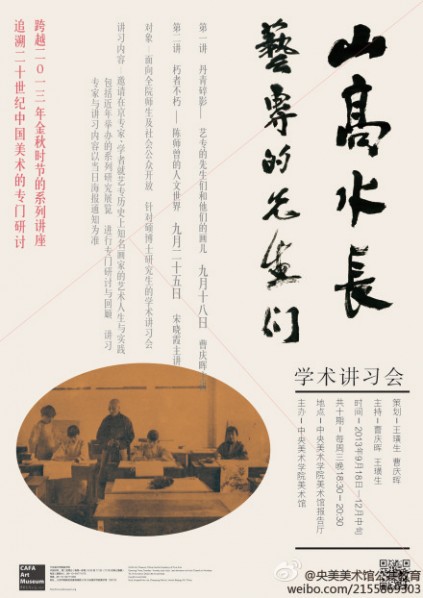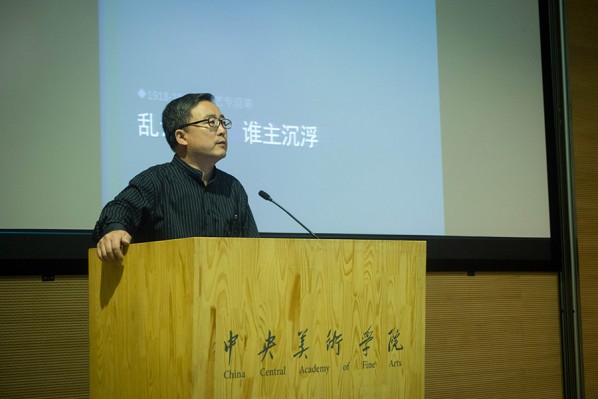
"Fragmental Shadows of Painting – Teachers in the Art School and Their Paintings” was held at the Lecture Hall in CAFA Art Museum at 18:30 on September 18, 2013. The lecture was presided over by Wang Huangsheng, Cao Qinghui was invited to speak. As a professor of the School of Humanities, CAFA, having an in-depth study of modern Chinese art, Cao Qinghui spoke in the first session of the series of lectures, roughly combing through the general background of the art school and the teachers.
The lecture was divided into three parts, introducing the development of the art school from three periods as the early period, middle period, and late period. In the late 19th and early 20th century, in the art circles there were patriots who cherished a common salvation as an ideal putting forward different artistic concepts. Kang Youwei, Chen Duxiu, Cai Yuanpei, Xu Beihong, Cheng Kam advocated Western realism, Chen Shizeng advocated the tradition and learning of new things, Cai Yuanpei put forward the concept of “aesthetic education”, which started from prenatal care, extending to many aspects such as urban planning, social aestheticism and so on, within a very wide range.

In such a social context, the National Beiping Art School was established, as the earliest public art school, which had experienced a development of twists and turns, being ill-fated. It had undergone several reforms and inland migrating. It was initially known as National Beijing Art School from 1918 through to 1928. It was renamed National Beiping Art School from 1928 through to 1937. Part of it immigrated to inland China from 1938 through to 1945, to establish National Art School in Chongqing, establishing the National Beijing Art School in Beijing. From 1945 through to 1946, the Ministry of Education specially set up the 8th Class of Beiping Temporary University Workshops. Eventually it was named the National Beiping Art School. It can be seen from the statistical table of reflection on the overview of the National Beiping Art School: Except for the individual specially appointed by the government, all former principals of the art school have been abroad, students returned after their overseas studies.
National Beiping Art School was organized by Cheng Kam when he returned to China in 1918. Cheng had been studying in Japan in his early years, as there was never a similar educational experience in China, Cheng set up the courses according to the Japanese teaching template. Cheng can be said to be the voice of realism. His painting is the fusion of China, Japan, the West, a true reflection of the object. At the early developing period of the art school, the teacher team mainly composed of Yao Mangfu, Chen Shizeng, Yu Shaosong, Tang Dingzhi, etc., and there was an important organization - Antique Exhibition Hall. The establishment of the antique exhibition hall meant that the royal private collection was opened to the public, which was very beneficial for painters to copy and study antique paintings, a good opportunity to borrow ancient factors to innovate from. CAFA Art Museum has collected 4 paintings of landscape, flowers and birds by Yao Mangfu, from the perspective of the collection, his works are based on Four Wang and Dong Qichang, supplemented with the ink of Song and Yuan Dynasties. Yao was also proficient in calligraphy, integrating this into the painting, straight from the heart. Chen Shizeng’s style was established on the basis of the study of Song and Yuan Dynasties, while it was obvious that Qi Baishi paid an important role in the formation of his style. Yu Shaosong was an official in the Beijing Ministry of Finance, being proficient in the study of monuments, a style of firmness and flexibility, vigorous, mellow and full, following his calligraphy style. In the early period, there were many different educational concepts in the art school, which didn’t inspire contradiction. Early development can be summarized as harmony but not sameness.
In the middle period of the art school, teachers included Yan Zhikai, Pu Hsin-yu, Chang Shuhong, Qi Baishi, etc. Pu Hsin-yu who laboured outside of the painting, which was unsophisticated and fresh, unconventional, a very elegant art style. Yu Feian’s paintings were originated from life, because of his perennial gardening and aviculture, he was very familiar with the habits of birds, allowing his painting of flowers and birds to be established on the basis of the comprehension of things, higher than the common observation. In and before the 1930s, Zhang Daqian learned from Shi Tao, and was very like him. In the 1940s, he went to copy the murals in Dunhuang, to hugely change his style. And his later splash-ink painting actually reached the pinnacle of his personal creation. Chang Shuhong was responsible for the teaching of Western painting.
He respected classicism, whose pictures were of a unique sense of decoration. At this period the teachers of the National Beiping Art School made some changes while inheriting the ways of traditional painting, rather than the stereotypical, it was compatible to use Chinese and foreign teachers at the same time, instead of inspiration being a big contradiction.
In the later period, the core of the faculty was made up of Li Hua, Zong Qixiang, Wu Zuoren, Ye Qianyu, etc., and the president was Xu Beihong. Xu Beihong was an overseas student returning from the West, and he was deeply appreciated by Kang Youwei. Due to the promotion by the complex political situation and his personal worship of Western realism art, when he was the president, he launched the “Chinese Painting Reform Movement”. He advocated “Sketch is the basis of all the plastic arts”, laid the “sketch” teaching in a core position. Xu Beihong spent all his life promoting “realism”, but in his own creations, including “Tian Heng and Five Hundred Persons”, and “The Foolish Old Man, Removing the Mountains”, etc., all of which belong to the theme as a metaphor of the current style by borrowing from the ancient stories. Seen from his works, Xu Beihong’s realism only reflects on realistic techniques, instead of deeply experiencing the labour involved in people’s livelihood. “Chinese Painting Reform Movement” of Xu Beihong was of a very complex background, when people learn, they should never put all the historical merits and demerits on himself. Moreover, Xu Beihong made a very significant contribution to art education, promoting many poor students, such as Wu Zuoren who studied oversea with the help of Xu.
At the end of the lecture, Cao Qinghui also recommended the book: “Road of Chinese Modern Art Illustration”, which was jointly edited by Prof. Pan Gongkai and himself. And he proposed a thought on the “modern artist”, on how to determine whether a Chinese artist is a modern artist or not. Cao thought that, the measurement standard was not a deliberately new technique, but of a modern understanding of traditional things, the establishment of a kind of understanding for further creations, artists who owned such an insight could be said to be modern.
Journalist: Zhang Gaoshan, Photo: Yang Yanyuan/CAFA ART INFO
Translated by Chen Peihua and edited by Sue/CAFA ART INFO




























